Microsoft Memories - a look back, at the past of Redmond technology
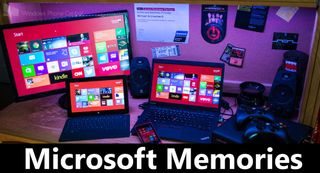
Sometimes technology is a collection of circuitry and silicon, sometimes though – it is a magical moment full of feelings and memories. The best experiences are born when technology transcends our knowledge and connects us with what we love. British science fiction writer and futurist, Arthur C. Clarke, once said:
“Any sufficiently advanced technology is indistinguishable from magic.”
Microsoft has been around for a long time and for those of us who live off of the technology they provide, some of the memories will never seep away.
In 2007, the company released a four minute commercial that has come to be known as “Your Digital Lifestyle”. The ad highlighted the then current hi-tech Microsoft products of the time and how one green shirted hipster used them to party the night away. The commercial is set to a cover of Ash’s Girl from Mars by Canadian group, Magneta Lane.
Buckle up, because we are going on a field trip to six years ago; along the way, we are going to jam with our green shirted friend and revisit some of our past Microsoft technology goodies. Windows Vista will probably be seen along the way, but there will be plenty of other experiences to combat that bad flavor.
Okay, roll the footage!
Windows Live Messenger
Our friend Mark, is at work and on his PC when he receives a Windows Live Messenger chat from his friend Pia (she must be the girl from Mars). Today we know that Microsoft’s messenger software is deprecated, but in 2007 – most of the world still used it. The service was first rolled out as “MSN Messenger” on July 22, 1999 until it was rebranded in 2005. Until its death, Microsoft reported that over 330 million active users a month used the service.
What happened next you ask? Microsoft purchased Skype and merged the two services. Finally in 2012, the service was killed in favor of fully utilizing Skype. This marks our first evolution of a Microsoft service: MSN Messenger -> Windows Live Messenger -> Skype with Windows Live Messenger -> Skype.
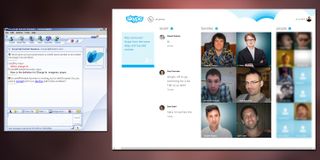
Windows Live Spaces
On we go! Pia sends Mark a link to Windows Live Spaces where he can check out party details and RSVP to the event. Windows Live Spaces was Microsoft’s poorly known social network and launched in 2004 as MSN Spaces. The goal of the site was to compete with other networking sites such as Facebook and Twitter (Sorry kids, grandpa didn’t have Google+ yet).
Get the Windows Central Newsletter
All the latest news, reviews, and guides for Windows and Xbox diehards.
The problem with Microsoft’s social networking platform was that it didn’t offer any differentiating features from its already popular competitor, Facebook. The network was shut down in 2011 and has not been rebranded or reestablished.
Microsoft has launched a new, but unrelated, social networking site called Socl which you can read more about here.
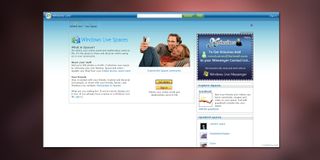
Live Search Maps 3D
Mark decides he wants to go to get his groove on, so he heads to Live Search Maps 3D and spins around a view of the city before dashing off. Why he spins the city around in circles, we can’t tell you. What we can tell you is what happed to 3D maps – they died. The service was an attempt to achiever near-photorealism of a city with high resolution models and aerial photography. Needless to say, the service was expensive and less than 68 cities were rendered before the program was dropped in 2010. According to Microsoft, they wanted to focus more on their new service – Bing Maps (more on that in a bit).

Windows Live Search
With his dashing lime green sweater now on, he pulls out his HTC phone and uses Live Search to look up traffic. Microsoft has been in the search game for a long time; they launched their first web search product in 1998 and crowned it, MSN Search. The newly launched service consisted of a search engine, index, and web crawler. It isn’t well known that from 1998 to 2005, Microsoft didn’t actually provide its own search engine results; the company partnered with Inktomi, Looksmart, and AltaVista until 2004 when Microsoft decided to go at it on their own.
In 2006, Microsoft rebranded MSN Search to Windows Live Search then changed their mind in 2007 and settled on Live Search. For the first time in history, Microsoft now powered their entire search engine internally. A problem still remained though, the company wanted to separate their search platform from their Windows division and “Live Search” just wasn’t doing the job. On June 3rd, 2008 – Microsoft launched Bing! Another evolution pattern emerges: MSN Search -> Windows Live Search -> Live Search -> Bing!

Zune
Now that Mark is safely buckled in and ready to put the petal to the metal, he docks his gigantic first generation Zune into a car dock and rocks some tunes. You will have to give me a minute to mourn Zune as it was one of my favorite Microsoft babies… okay, I’m good now.
Zune was launched in November 2006 as a direct competitor to Apple’s line of iPod multimedia devices. Toshiba helped design and develop the first generation Zune units under code name “Argo”. The original Zune was criticized for its bulky size and it’s (uh) interesting color choice of brown. It also didn’t help Microsoft that on December 31st 2008 at midnight, many first generation Zune 30 GB models froze due to an internal clock driver problem - luckily the devices resumed working 24 hours later.
The second and third generations of Zune were manufactured by Flextronics and gave birth to the squircle (not to be confused with the Pokémon, squirtal) shaped Zune Pad; this ingenious touch-sensitive pad allowed users to flick through content or click in on the edges to navigate the metro style interface.
On September 15, 2009 the last and final fourth generation Zune was released – the Zune HD. Oh, the excitement I remember experiencing when I ran to BestBuy and picked up my beautiful Zune HD with platinum backing. The design of the unit was superb, taking cues from industrial styling. And of course I could not forget the OLED touch screen which, at the time, made the iPhone look dull and washed out. Unfortunately, Apple’s iPod Touch had accumulated a massive store of applications while the Zune HD’s list of apps could be counted on two hands.
On March 15, 2011 Microsoft’s Zune brand was killed as it failed to capture any significant market share. Zune isn’t completely gone though, it has been rebranded. Production of any Zune players may have stopped, but the Zune Marketplace services were rebranded as Xbox Music and Xbox Video. The spirit of Zune continues to live on within Microsoft’s Windows Phone line of devices.

Games for Windows
Back to Mark - unfortunately his car has failed him and like any true hipster, he has a foldable bike in his trunk. He hops on his bike and pulls out Live Search once again to find directions to the closest pizzeria (although, if he lived in the area, you think he would know where a pizza place is located). After arriving at the pizza place, a semi-psychotic man jumping up and down playing a shoot-em-up video game, is behind the counter. Video games on a PC? This must be a Windows machine!
One of the major reasons Microsoft has been able to keep its following, is PC gaming. For the intense gamer, the PC platform provides a more open and moldable playing field. Using online stores like Steam, gamers can access a barrage of content available for download. Faster and more powerful hardware allows for graphics that can blow consoles out of the water. Quite frankly, if you haven’t played Crysis on Ultra settings with three surround-view monitors – you haven’t lived.
Games for PC were not united under a single brand name until 2007 when Microsoft launched “Games for Windows”. The new service and branding allowed Windows Vista games to access the Xbox LIVE service. With Games for Windows, players can cumulate achievements, chat with friends, and more. Some games, like Shadowrun, allowed for cross platform play between a Windows PC and Xbox 360 game console. The service was eventually renamed to “Games for Windows LIVE” with support on Windows 7 machines. Newer, Windows 8 machines, take advantage of their Xbox integration and run games under the title: “Xbox LIVE on Windows”.
Whatever you would like to call the service, it did not fair too well. The marketplace based around “Games for Windows” was eventually scrapped. Microsoft may be the number one PC platform for gaming, but in terms of a marketplace – they are ages late. Most PC gamers will love to tell you all about their devote loyalty to the Steam Marketplace; while they do that – let us, move on.
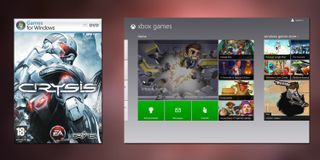
Xbox 360
The commercial snaps away to a scene of party goers (does that give away how often I am not invited to parties) gaming on an Xbox 360 game console.
Xbox was launched in North America on November 15th, 2001 to compete against Sony’s PlayStation 2 and Nintendo’s GameCube. The idea was first pitched in 1998 by four engineers working on Microsoft’s DirectX team. The engineers built a prototype Windows based console from pats of a dissembled Dell laptop. The idea was pitched to executives and eventually approved.
The marketing team at Microsoft hated the Xbox name and made many suggestions in favor of a name change. In the end, consumer testing had revealed that Xbox was the preferred name for the console and it stuck. If you haven’t figured it out yet, the name Xbox, was derived from the word “DirectX” – the software platform the console was based on.
The unit launched with impressive features such as Xbox LIVE, an online based gaming service with buddy list integration, and a build in HDD, to store save game data without the need of a memory card. For those wondering, the internal specs were as follows: Intel Pentium 3 CPU, 8-10 GB HDD, 64 MB of RAM, and a 233 MHz NVidia GPU.
Microsoft’s first step into the console world was a success with the Xbox selling over 24 million consoles.
The Xbox 360, the console seen in the commercial, was the second game console developed by Microsoft and the successor to the original Xbox. The unit competed against the PlayStation 3 and Nintendo Wii and sold 70 million consoles as of September 2012. The console was a hit and sold out upon release in all regions except Japan.
Stepping up from its predecessor, the Xbox 360 contained a PowerPC tri-core CPU, a 500 MHz ATi GPU, 512 MB of GDDR3 RAM, and 4GB – 250 GB of internal storage.
Later this year Microsoft will be launching the Xbox One, a new game console, with tight TV and Windows 8/RT integration. The unit will feature an eight-core AMD CPU, AMD DirectX graphics, and 8 GB of DDR3 RAM. If you missed the original announcement for the console, you can check out our Reveal Day Overview here.

Windows Mobile
While our “bestie” Mark is out, the girl from Mars sends him a picture text message via her Windows Mobile device - she needs beer and chips!
Windows Phone Central is all about Microsoft’s latest mobile operating system and we could spend a week giving you the lowdown on the evolution of Windows Mobile, so here is the very just of it.
Windows Mobile was launched on April 19th, 2000 and originally called Pocket PC. In 2003, Microsoft decided to rename Pocket PC to Windows Mobile.
The software was released in four editions including: Windows Mobile for Pocket PC Premium, Windows Mobile for Pocket PC Professional, Windows Mobile for Smartphone, and Windows Mobile for Pocket PC Phone. If you think that naming scheme is confusing, just imagine how the average consumer felt.
Eventually, Microsoft narrowed down the operating system to three different iterations including: Windows Mobile Professional, Windows Mobile Standard, and Windows Mobile Classic. Professional was designed to run on smartphones with touchscreens, Standard was designed to run on mobile phones without touchscreens, and Classic was designed to run on PDAs or Pocket PCs (AKA: Anything without a mobile broadband connection).
In 2004, Windows Mobile’s market share was 11.3%; it increased to a maximum high of 42% in 2007 and then decreased down to 3% by 2011 – Blackberry and iPhone were becoming too strong of a force to deal with.
On November 8th 2010, Microsoft launched its successor to Windows Mobile – Windows Phone. Besides the massive changes to the front end of the OS and a complete recoding of the backend, Windows Phone was aimed at an entirely new market audience; the previous phone OS from Redmond was aimed at business users and enterprise, while Windows Phone is aimed at consumers.
Currently, Windows Phone has a growth rate of 133% per year, surpassing Android OS’ 79.5%. As of now, Nokia dominates the Windows Phone hardware market with an 83% share outside of the United States of America.

More Zune
Like any good guy chasing a girl, Mark follows the instructions Pia has sent him, and heads to a local convenience store to pick up the goods. While there, he notices the cashier has a Zune also and decides to squirt her.
No, get your mind out of the gutter you internet reader! Squirting a user was a feature on Zune in which you could easily share your music wirelessly with others. It was important to note that if the user did not have a Zune Pass they would only be able to share a sixty second clip.
After Mark squirts the woman behind the counter (seriously guys, stop thinking like that) he rushes out of the store and heads over to the party he has been so anxious to get to.
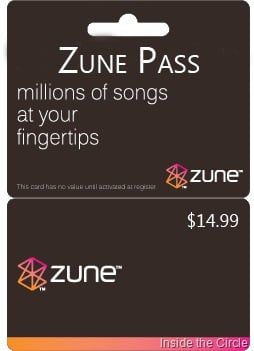
Windows Live Essentials
Know what is cooler than viewing pictures of a party? Viewing pictures of a party while you are still at that party. The girls decide to take a barrage of photos and (because nothing else fun is going on) organize and share them with Windows Live Photo Gallery.
Apple’s Macs have come preloaded with iLife, a suite of video and photo editing software, for years. Microsoft needed to badly cut in on the home multimedia action for their Windows platform. In 2006, the company released what they called “Windows Live Essentials” – a package that included: Windows Live Messenger, Windows Live Photo Gallery, Windows Live Movie Maker, Windows Live Mail, Windows Live Writer, SkyDrive (formally Mesh), and Windows Live Family Safety Tools.
The software has proved to work well and it is in its fifth wave (or distribution). The software suite, had been renamed to Windows Essentials in its last release; this ensured that the brand name stayed in line with Microsoft’s corporate setup. Just as Live Search was renamed to Bing, Windows Live Essentials was renamed to Windows Essentials - dropping the “Live” branding.

Windows Vista
Mark finally arrives at the party with a collection of pizzas and starts dancing the night away. And as we all know, the perfect way to end a commercial is with Windows Vista – oh my. We have to talk about Windows Vista now, don’t we? Let’s do this, to spare you pain and to spare myself pain, I will make the Windows Vista discussion brief.
Microsoft’s redesigned operating system Windows Vista was released six years ago on January 30th, 2007. The list of criticisms for this iteration of the Redmond OS can go so long that there is an entire Wikipedia page (and many angry webpages) devoted to it.
Here is the just of the worst Windows Vista features: To start, the operating system was incompatible with almost all Windows XP drivers because the code base was rewritten; this caused extreme hardware issues with new and old devices alike. It took manufacturers months to provide correct driver compatibility and even then – they didn’t work too well.
Windows Vista was also the introduction of User Account Control, a software mechanisms designed to keep users safe when installing content or running applications as administrator. The problem – the feature was over intrusive and constantly nagged at you to approve EVERYTHING.
Let’s conclude with the fact that Windows Vista was bloated and slow. The new aero interface taxed heavily on your graphics card and the system seemed to have no mercy unless you had the top of the line hardware.
Want to know a secret of mine? Windows Vista was so bad, that I ran out and purchased a MacBook Pro. That is right, I switched to Mac during the Windows Vista years and returned when Windows 7 was released.
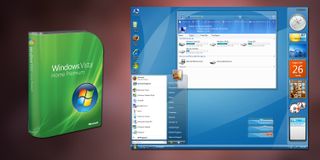
The Road Ahead
I’ve had a ton of fun taking a semi-brief look back at Microsoft six years ago. The company has changed much since then and we are being shot forward into a future of crazy bright colors and live tiles. Technology is an industry that is moving faster than ever and it is almost impossible to properly predict. Will Xbox One be a hit or flop? Will consumers grow to love Windows 8 or not? We will have to wait and find out – this road trip is over.
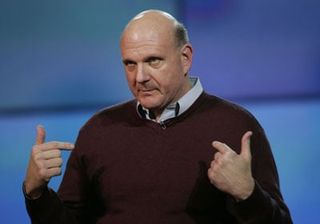
If you are wondering what happened to our friend Mark at the end of the video, check it out for yourself.
Tell us, what is your favorite piece of Microsoft nostalgia? I personally, to this day, remain in love with the Zune line of devices. In fact – just last night I had a dream that I was running Spotify off of my old Zune HD…. Probably a sign that I need a vacation.
Chat soon fellow Microsofties!

